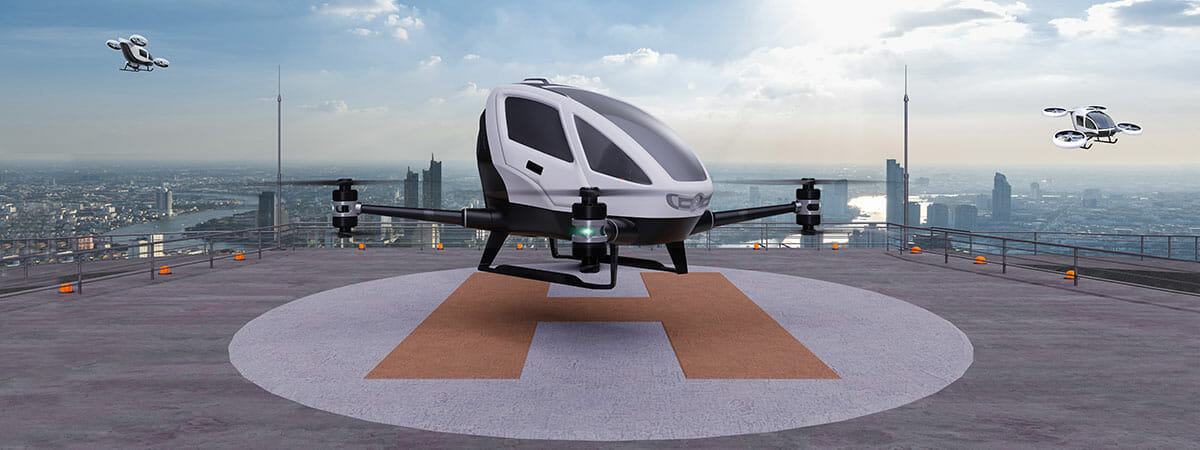A few years ago, when we heard the news about the impressive prospects in using drones for the delivery of goods, it was always linked to companies like Amazon, Google or DHL – who ensured that there was extensive media coverage. Many gurus even forecasted the launch of extensive drone-based air distribution systems in just a few months.
Over time, we have realised that the reality is quite different. Drone-based goods distribution is still under development, and there is still some time left to get off the ground, beyond mere pilot tests or PR.
Although there are still some technological challenges to be addressed, the main hurdle for AAM to be set in motion resides in legislation, policy and public acceptance.
It’s true that with regard to delivery drones themselves, the technological challenge is adequately addressed in most cases. There are some areas where improvements will continue to be made, such as battery life, noise reduction or signal coverage between operator and drone. Still, the reality is that we are talking about a fairly mature technology.
Another issue, however, is everything related to autonomous air systems for transporting passengers or larger goods. There are already a good number of examples of e-VTOL (electric Vertical Take Off and Landing) aircraft around the world. In these cases, the safety component is more critical because passenger safety imposes much stricter criteria. Even so, we have already seen them flying with passengers. It is clear that solutions to current limitations are on track, and these issues will be addressed in the short term.
In any case, even if the technology has already addressed all the challenges posed by safety and the features of all types of UAS and e-VTOL on the market, there are some barriers that prevent us from seeing hundreds of drones distributing goods or aircraft transporting passengers today.
The three main obstacles are: the technology required for the automatic management of urban airspace, the development of autonomous flight systems and legislation relating to the use of urban airspace.
Under the conditions of use envisaged in the context of AAM (Advanced Air Mobility), urban and peri-urban airspace requires an automatic management system that allows all air systems to coexist efficiently and safely. Unlike ATM (Air Traffic Management), fragmented air transport in the urban environment, with thousands of aircraft operating simultaneously, will not allow people to coordinate each flight in a personalised manner. It will also be necessary to secure sensitive issues such as the continuity of communications or network security to avoid any breaches.
The second challenge to be addressed is operational flight autonomy. In an urban airspace with hundreds of aircraft in the air, it is unrealistic to think of air traffic with pilots at the controls of e-VTOLs. It is advisable to leave the human factor out of this delicate equation and to opt from the outset for automated systems.
In fact, automatic flight is relatively simple and widely used by the most advanced companies. But the system’s real-time decision-making in the event of any flight event affecting its safety is an unresolved matter. We should bear in mind that aircraft must have the capacity to make decisions in the event of unforeseen events and, furthermore, that they are compatible with decisions taken by other aircraft at that same time.
The third barrier is not technological, but unfailingly human. We will need to build a new regulatory framework that will allow aircraft to travel through the airspace of cities and their surroundings, in addition to regulating the corresponding services they provide in each case or foreseeing the conditions to build or develop spaces for their use as vertiports. Regulations must also be compatible with prevailing laws and uses in their area of application and, in addition, they must be integrated with legislation at higher levels (regional, national). It is true that the major international air regulatory bodies are already making progress in this field, but for the time being no one has addressed the necessary integration with the entities that will ultimately have legislative responsibility: city councils. This same legislation must serve as a framework for certifying the facilities that are going to be related to urban air services.
The aviation safety authorities (and especially EASA in Europe) are making an effort to regulate this field, but there are some aspects that are still outstanding. Everything related to the requirements of operators, pilots or aircraft has been regulated since 2021, and now it is the countries that are adapting the regulations to each specific case.
The new regulatory framework will come into force in January 2023, following its approval in April 2021, but it will take “something more” to manage the traffic of delivery drones, together with larger UAS, in an automated manner and integrated with manned aviation.
This concept is what is called U-space, which we could define as the set of services and procedures that will enable operations with unmanned aircraft – especially those which are more complex – in an orderly, smooth, and safe manner.
In fact, legislation is the main obstacle encountered by this sector for its development. There is no doubt that we will have a legal framework sooner or later, but the dependence on technicians, civil servants, politicians and various institutions only slows down a journey that, as we have already mentioned, has been addressed from a technological point of view.
With this scenario, it is no wonder that the companies having announced their involvement in the drone distribution sector in the media have stopped to wait for more favourable conditions.
This is where we see how tradition in societal behaviour has also played against it, as, once again, legislation is lagging behind technology.
However, let us not lose sight of the fact that this regulatory problem becomes more relaxed when relating to humanitarian initiatives in areas where legal barriers are lower or, at the very least, can be overcome.
There are many examples already on the use of UAS and drones for delivering medicines, emergency goods or packages in hard-to-reach areas in Africa, Latin America or remote islands. There have been examples of success that have brought immediate benefit to society and that have solved traditional problems caused by the isolation of some communities.
In December 2018, one of the first real and relevant experiences in this regard occurred when UNICEF was able to get a vaccine to a girl using a drone. This was on the island of Erromango, in Vanuatu (South Pacific), where a drone travelled about 40 kilometres through mountainous and jungle areas to access the Cook Bay community, without land access or electricity. The drone carried a refrigerator with ten doses of basic vaccines that were released (protected by polystyrene foam) in the community, where they could be used in optimum storage conditions. Several years have passed since that delivery…
There is consensus that it will all happen eventually. The use of drones for the distribution of goods has proven to be effective and productive for companies that have carried out pilot projects in this regard. The same happens in the transport of people by air in intercity and urban environments. The question is how long it will take to see it widely adopted.



